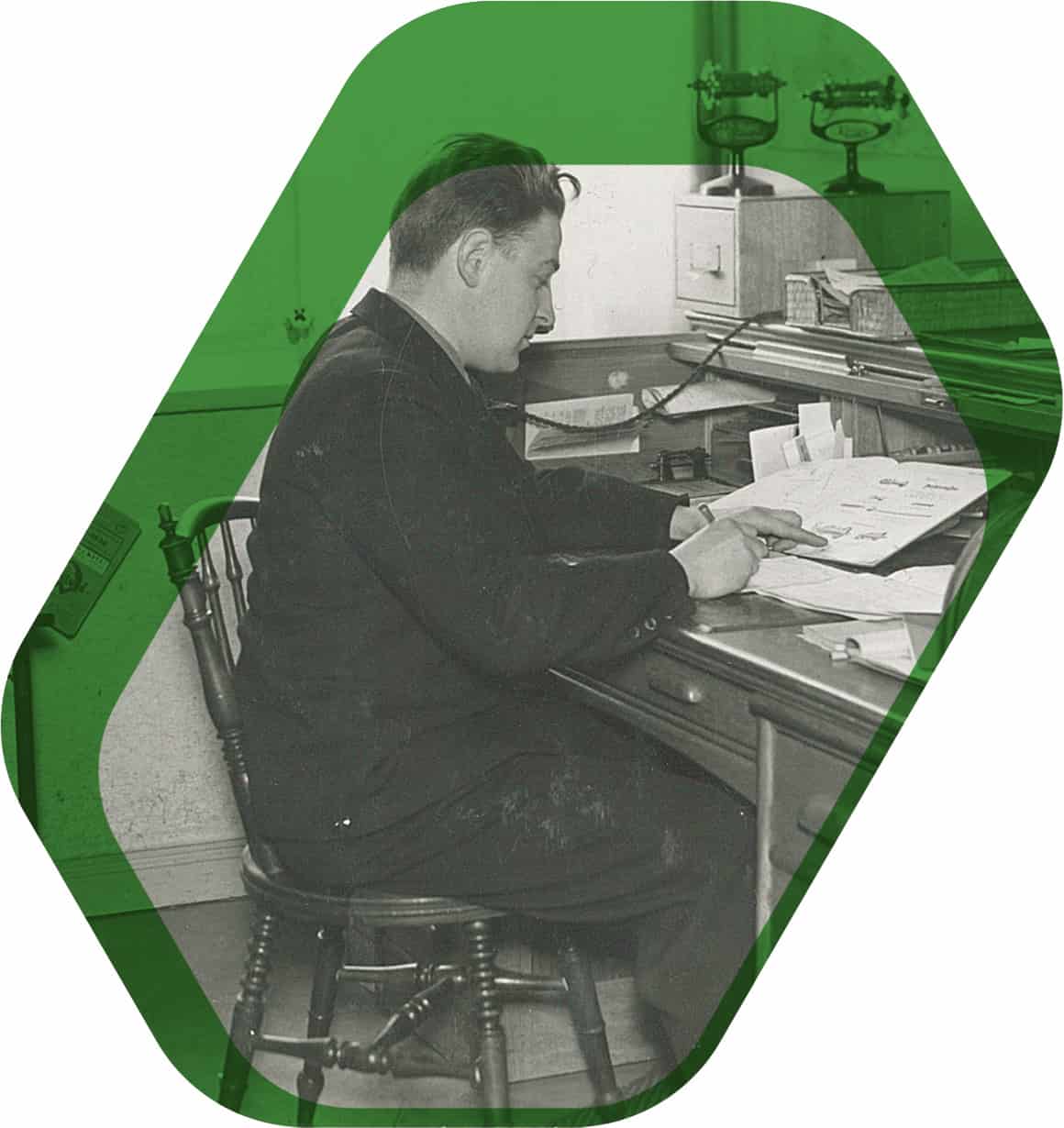
Company
HISTORY
On 22 October 1922, the brothers Aarne and Eero Harkke founded Pyöräkellari Oy in Turku, which started its own bicycle manufacturing in the 1930s. A large part of the bicycle parts were imported from England and the brand High Land was also bought with them. It was translated into Tunturi, the Finnish word for the fells typical of Lapland.
The 1920s
Aarne Holmberg, later Harkke, founded a bicycle company in Turku at Eerikinkatu 19, in 1922. According to official documents “the main work carried out in the shop will be repair work of bicycles and other small mechanical equipment”. Aarne’s brother Eero and sister Lyly joined the company a little later. In the early 1920s, a bicycle was still quite a rare sight. Gradually bicycles became increasingly affordable for the working population, which increased the need and popularity of bicycles considerably. Especially for the rural population, a bicycle was a new mode of transportation, and it did not replace any previous form of transportation. On the other hand, social life became livelier as bicycles made it possible getting to hobbies from further away. The bike was also a sign of an independent, self-sufficient man, which allowed you to also look for a sweetheart further afield. The profession of errand runners riding cargo bikes was born in the 1920s, making the speed and efficiency of the cargo bike known. As the number of sold bikes increased, so did the number of bike shops. In 1922, a total of 985 bicycles were registered in Turku, but six years later that number had already increased to 2,698 bicycles.
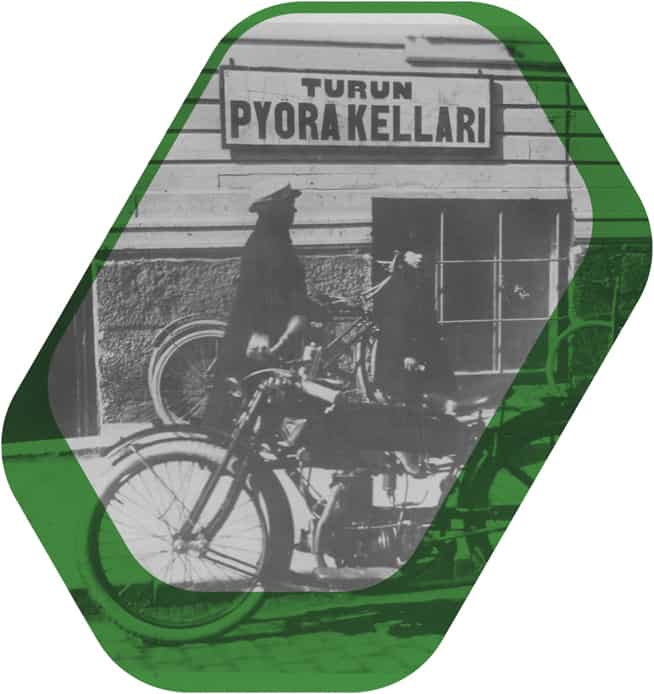
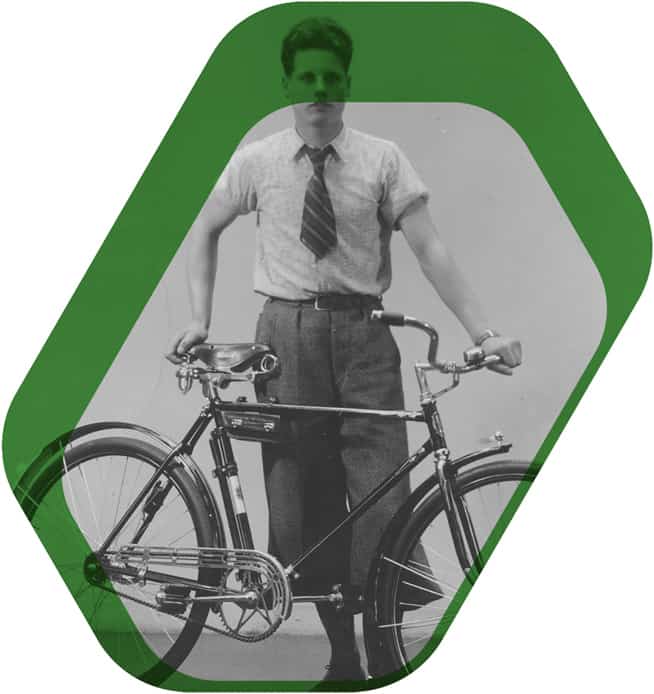
The 1930s
The global recession also reached Finland. There was a severe shortage of everything and livelihood was generally poor. An important factor that contributed to the bicycle industry surviving this era of shortages was the sale of spare parts: when people could not afford to buy new bicycles, old ones were put into use. The middle of the decade saw the selection of bikes available starting to diversify. A need for bikes equipped with low-pressure tyres was caused by the deterioration of roads due to the increase in the number of cars and their increased commercial use, for example in various professions. The first experiments with bicycle lanes were carried out in Turku and Helsinki. Competition was fierce, so whoever could provide the best combination of price, quality and distribution would end on top. Everything was regulated. The bicycle sales distribution routes became more established in the good years that followed the shortages. Pyöräkellari built their distribution around a network of exclusive dealers, mainly repair shops.
The 1940s
During the wars, there was a significant increase in the need for bicycles. The army only had a total of 7,300 bicycles, and 10,000 more were obtained from the citizens for the war. During the war, tyres and raw materials were in short supply – the needs of the army got first priority. At the beginning of 1942, the Finnish Ministry of Supply declared all bicycle tyres to be confiscated. The prerequisite for obtaining a purchase licence was a commute of no less than five kilometres, invalidity or a similar weighty justification. At the time, Pyöräkellari in Turku had ten vulcanising machines, that five employees used for repairing 30–40 tyres every day. Due to the lack of raw materials and parts, bicycle factories had to invent other products. Pyöräkellari manufactured prams, figure skates, carts for goods and delivery as well as hearses. Most important war supplies included refurbishment of grenade shells and the basic repairs of army motorcycles. Towards the end of the war, they also started manufacturing wheelchairs. The company also carried out its social responsibility by organising three-month courses for war invalids who wanted to become bicycle mechanics. The list of participants makes it clear that many would go on to establish their own shops.
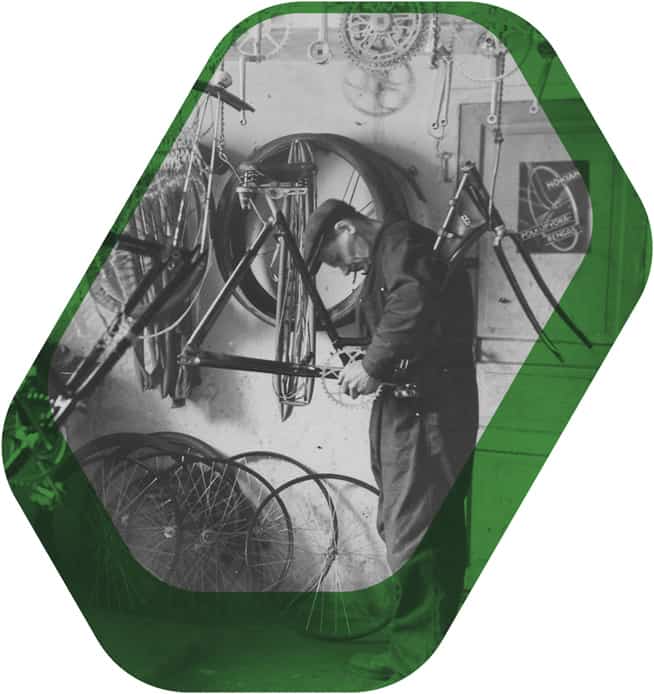
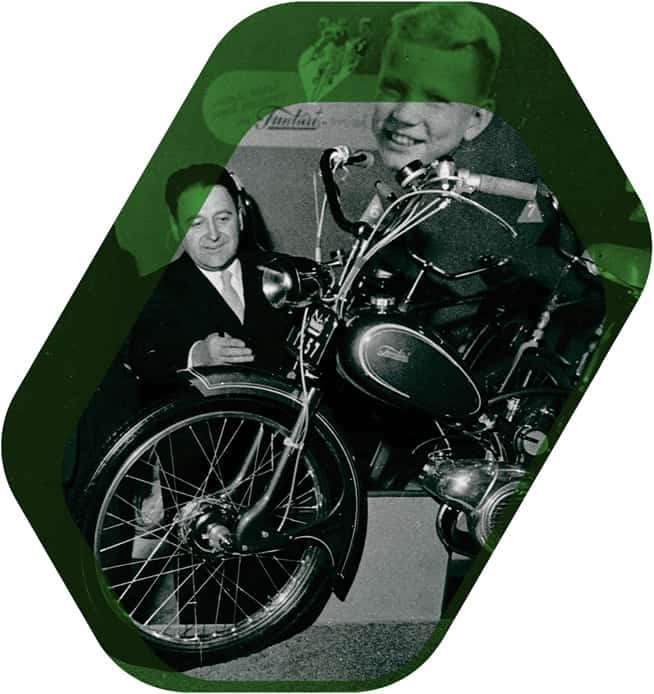
The 1950s
The 1950s were a very demanding time for Tunturi. The difficulty of obtaining raw materials and the construction of a new factory caused numerous financial challenges. The year 1957 also saw the start of the serial production of mopeds, and a couple of years later the plate-framed moped that became known as the “Pappa-Tunturi”. Tunturi had already before assembled motorcycles, but there were clear reasons for the popularity of the moped: cars were still few and far between and there was also a shortage of motorcycles, which were also quite expensive. Finnish moped designers did not have many role models. A tube frame seemed like a natural solution, because it allowed making use of the experience in processing of tubes gained in manufacturing bicycles. The name of the new vehicle, on the other hand, remained problematic for a long time. The Institute for the Languages of Finland recommended “nopso”, but that never saw any use. The law classified the vehicle as a motorised bicycle, but advertising and other writing, took up the name “mopedi”, adapted from Swedish. Colloquially many used “mopo”, which was avoided at first because a competitor had named their first model “mopo”. Teollisuusyhdistys received the right to use the name “mopo” on 4 April 1959. Tunturi quickly became the leading moped factory. In the 1960s, the popularity of mopeds picked up sharply and Pappa-Tunturi took over a large part of the market. A total of 415,000 of the classic moped was sold. The production of Pappa-Tunturi ceased in 1987. When cars started to become more commonplace, the demand for mopeds aimed at adults started to wane. Tunturi stopped the production of mopeds in 1998.
The 1960s
Manufacturing only summer products was an issue for Tunturi. To balance out its production, the company ended up designing and manufacturing fitness equipment. The exercise bike was the result of long development and design work, and production which began in 1969. The year 1968 saw the introduction of the first exercise bike called a “kuntometri” (fitness meter). Its successful launch was thorough: direct advertising was used to approach the most important influencers, doctors and the authorities. Tunturi developed a completely new system for their exercise bike – a combination of a disc brake and spring balance, for which patents were applied for in Finland, England and Germany in 1968–1969. In Finland, the device was known as the Tunturi fitness meter. More than one million W1 exercise bikes were produced: its popularity was based on its ease of use. The fitness meter was the world’s first device for measuring fitness aimed at home users, and Esko Kotamäki played a significant role in the product development. In addition, the exercise bike fit into a very small space and could even be easily transported in a car. Later, the selection expanded to a rowing machine and a mechanical treadmill. Export of fitness equipment did well in the 1970s and 1980s, and it had a great impact on the development of the entire company.
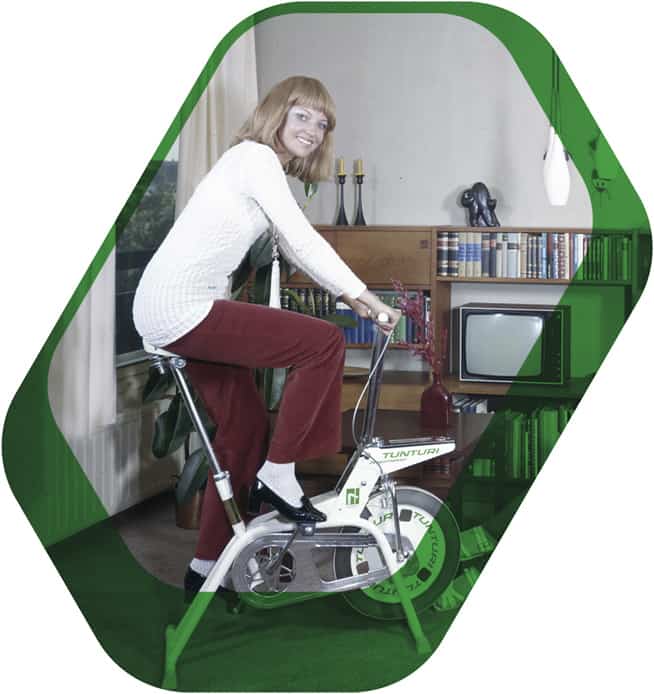
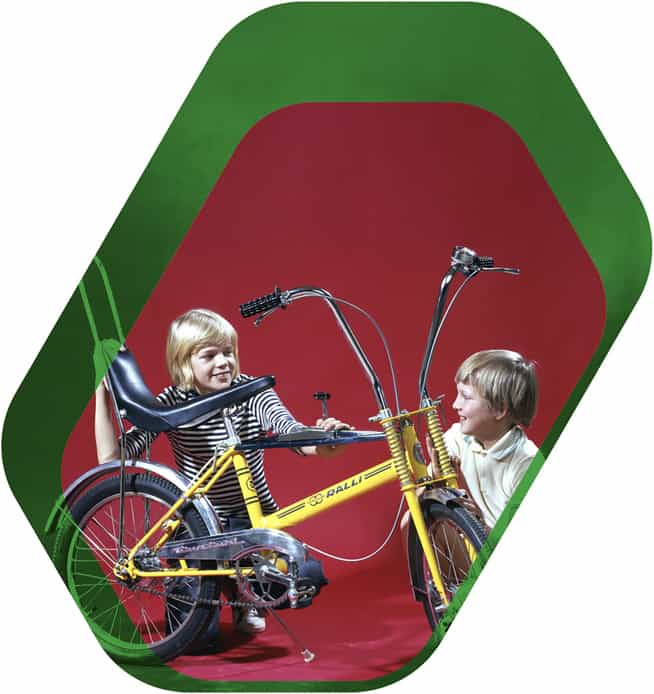
The 1970s
Since the very early days, Tunturi has always offered bicycles to meet the needs of children and young people. Production of the first children’s bikes started already in the 1950s. In 1972, the boys bike “Ralli” (rally) became very popular as soon as it entered the market. It had a special “banana saddle” with a high rear bar. Other special features included a raised handlebar and a box shifter in the frame. Bicycle accessories and equipment were also part of the selection. Child seats were already available for transporting small children, providing a significant increase in safety. In the 1970s, fitness and exercise were seen as a necessary hobby for everyone. Cycling got a boost from this, as commuting by bike allowed combining exercise with utility. The energy crisis of 1973 prompted people to think about modes of transport that were more cost-effective compared to private cars. Society recommended the use of bicycles and women in particular got involved. The bicycle was seen as a solution to the problems of short-distance commuting. The number of bike lanes also increased significantly. In the mid-1970s, Tunturi reached the position of market leader. Its fitness equipment was exported to many different countries and sales operations, collections and field work all developed steadily. As a testament of this steady improvement Tunturi received the Entrepreneur of the Year award in 1976.
The 1980s
In the 80s, the “Suomi pyöräilee” (Finland cycles) campaign gathered all different parties to promote cycling. The number of bike lanes in Finland tripled in the space of ten years, increasing the number of cycling enthusiasts. Tunturi kept up a steady pace of investment throughout the decade. Robots were introduced in manufacture and surface treatment lines were revamped completely. The production of fitness equipment also continued at a brisk pace. Women’s cycling enthusiasm did not go unnoticed at Tunturi, and the company aimed to find popularity among women by developing bikes sold based on fashion and appearance. When bike sellers were increasingly branded as mere sports shops, Tunturi tried to bring out the bicycle and the brand already in shop’s appearances. Tunturi adopted the slogan “Tunturipalvelu” (Tunturi service) for all public appearances and also leveraged being Finnish in its advertising very strongly.
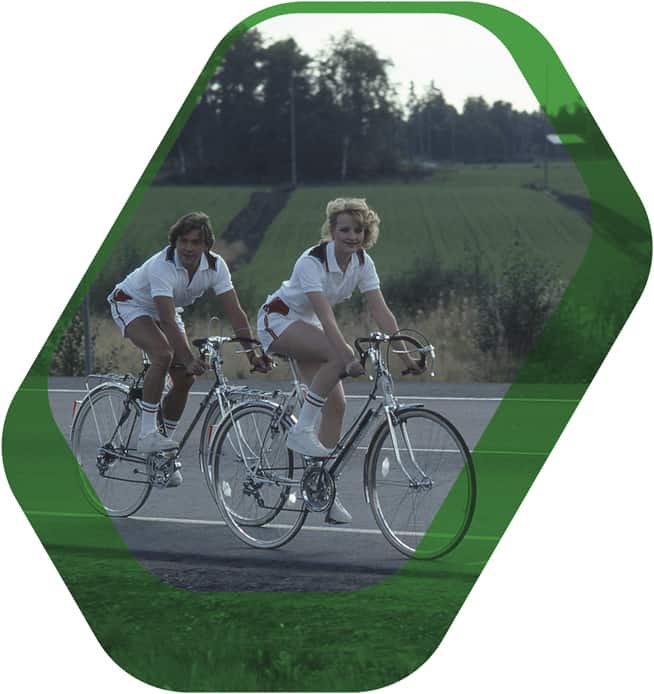
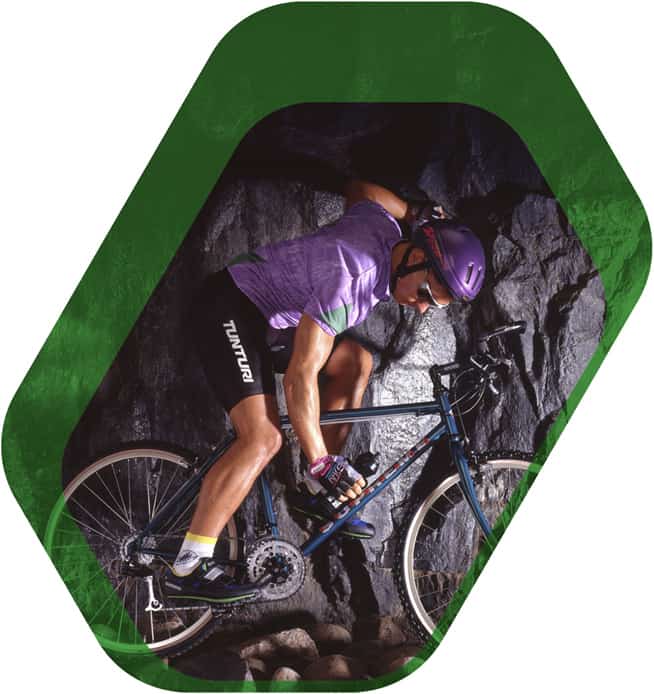
The 1990s
The 1990s can be considered the golden age of the mountain bike as it spread from North America to Europe and Finland. In 1993, the bicycle component manufacturer Shimano organized a design competition. Tunturi participated and placed among the top. The success kickstarted Tunturi’s manufacture of mountain bikes. Where Tunturi had competition in the manufacture of other bicycles, it was truly a pioneer when it came to mountain bikes. It used an advanced method, plasma welding, in manufacturing its unique steel frame mountain bikes, setting it apart from the competition. Tunturi also actively promoted cycling. Successful Finnish mountain bikers formed several Tunturi teams, which represented the brand at industry events and competed on Tunturi bikes. Famous team members included Katja Repo, Pia Sundstedt, Katariina Ebeling, Simo Kirssi, Marina Rantanen and Kari Myyryläinen. Tunturi handcrafted special racing bikes for downhill riders. Katja Repo won the Downhill World Cup bronze in 1997 on a Tunturi Progression bike. Ilona Luukkonen won the Bike Messenger World Championships, bringing another gold medal to Finland.
The 2000s
The arrival of multi-purpose bicycles started in Finland already in the mid-1960s. In 1967, Tunturi responded to the market challenge by launching Poni bikes, which quickly became Finland’s most popular bike brand. The launch tripled Tunturi’s sales by the end of the 1960s. The idea behind the new multipurpose bikes was that all family members – from the youngest to the oldest – could use the same means of transportation. Adjusting the bikes would be as easy as possible and could be done without tools, while maintaining good rideability. Poni was ascetic in its equipment, usually single-speed. Instead, it offered several colour schemes, which taught Finns to demand trendy colours of their bicycles. Poni helped create the foundation of a new Finnish cycling culture. People began to use the bicycle for exercise, utility and leisure. Poni was re-launched in 2010. New features of Poni included a front luggage rack and basket, and 3-speed models were introduced. In addition, new, more suitable models were introduced for young people and children: Maxi 20”, Midi 16”, Mini 12” and the kick bike Micro Poni for the very smallest.
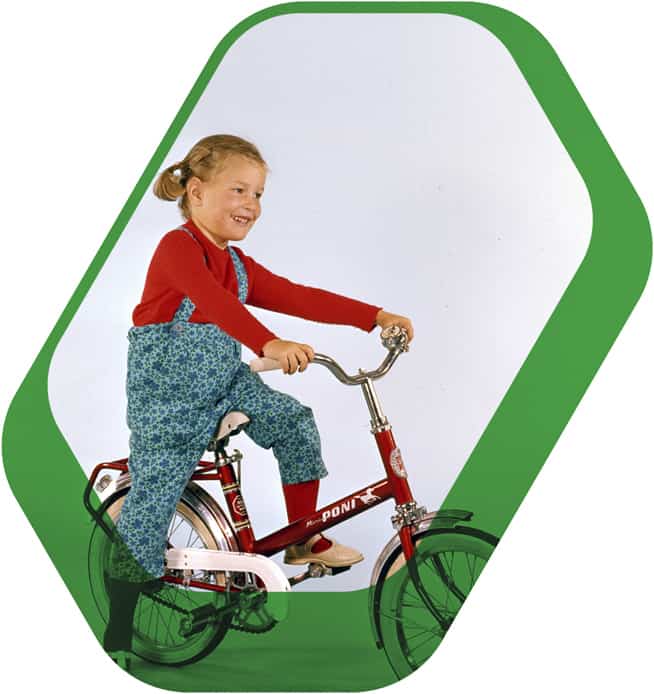
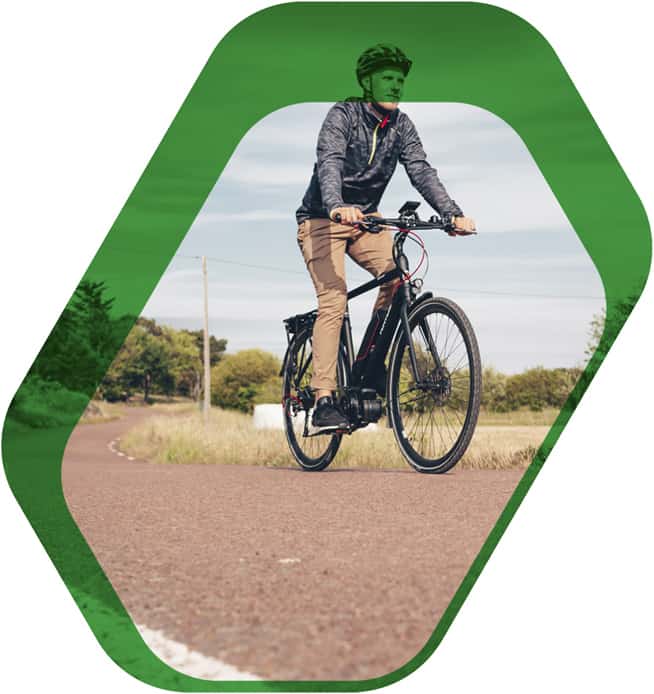
The 2010s
In the 2010s, there were an estimated 3.5 million bicycles in Finland. The role of cycling has changed over the decades – these days bikes fulfil many tasks and have many uses. A bicycle is first and foremost a means of transportation, but cycling must also be fun. Cycling as a hobby has evolved into many subcultures, and its importance as a form of exercise and sport has grown. Group cycling is emerging as a new form of cycling. Socially, cycling is viewed very positively. Finland is not yet at the level of traditional cycling countries, but cycling routes and light traffic lanes are constantly being developed. Bicycle commuting in particular has positive effects on society, reducing emissions and promoting public health. The bicycle of the future will be electric. As an example, 14% of the bicycles sold in the Netherlands are already e-bikes. An electrically assisted bicycle, or more familiarly, an e-bike, makes riding easier, especially uphill and long distances. The e-bike is especially suitable for bicycle commuters, active seniors, those without a driver’s license and ecologically minded people.
The 2020s
In the 2020s, the popularity of cycling has continued its strong growth. Tunturi Oy Ltd has taken over the responsibility for sales areas of Sweden and Norway and founded Tunturi Sweden Ab in Sweden. Tunturi has completely sold off its fitness equipment business and focuses purely on the manufacture of bicycles along with the import to the Nordics of the international brands of its parent company Accel Group: Ghost, Haibike, Winora, Lapierre, Batavus. Today, Tunturi’s filial CSN is responsible for accessory sales. E-bikes have increased considerably and offered even more opportunities for enthusiasts. Electric assistance makes bicycle commuting possible even on longer commutes. Electric assistance also provides people pedalling off-road with the opportunity to take on longer rides and more challenging trails. Fat bikes, such as the Tunturi eMax in the photo, have gained great popularity. Rental companies all over Finland offer opportunities to enjoy nature on a fat bike.
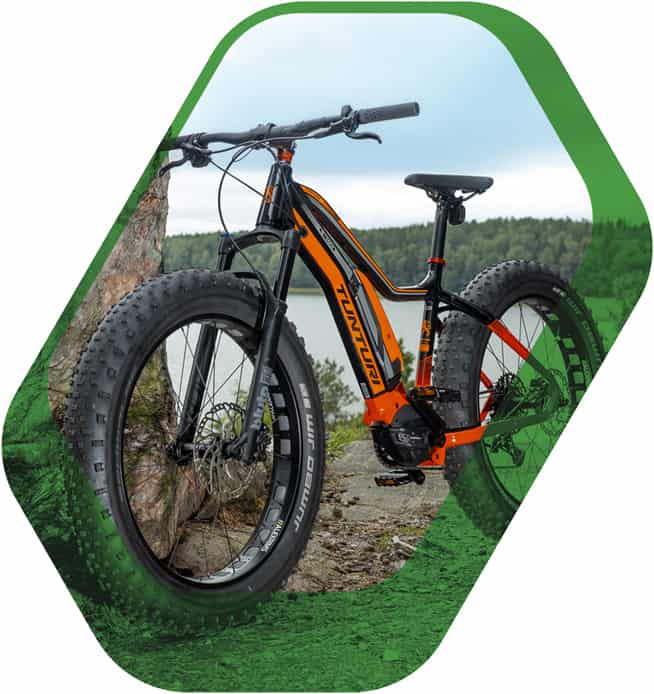
HISTORY
On 22 October 1922, brothers Aarne and Eero Harkke founded Pyöräkellari Oy in Turku, which started its own bicycle manufacturing in the 1930s. A large part of the bicycle parts were imported from England and the brand High Land was also bought with them.
It was translated into Tunturi, the Finnish word for the fells typical of Lapland.

The 1920s
Aarne Holmberg, later Harkke, founded a bicycle company in Turku at Eerikinkatu 19, in 1922. According to official documents, “the main work carried out in the shop will be repair work of bicycles and other small mechanical equipment”. Aarne’s brother Eero and sister Lyly joined the company a little later. In the early 1920s, a bicycle was still quite a rare sight. Gradually bicycles became increasingly affordable for the working population, which increased the need and popularity of bicycles considerably. Especially for the rural population, a bicycle was a new mode of transportation, and it did not replace any previous form of transportation. On the other hand, social life became livelier as bicycles made it possible getting to hobbies from further away. The bike was also a sign of an independent, self-sufficient man, which allowed you to also look for a sweetheart further afield. The profession of errand runners riding cargo bikes was born in the 1920s, making the speed and efficiency of the cargo bike known. As the number of sold bikes increased, so did the number of bike shops. In 1922, a total of 985 bicycles were registered in Turku, but six years later that number had already increased to 2,698 bicycles.
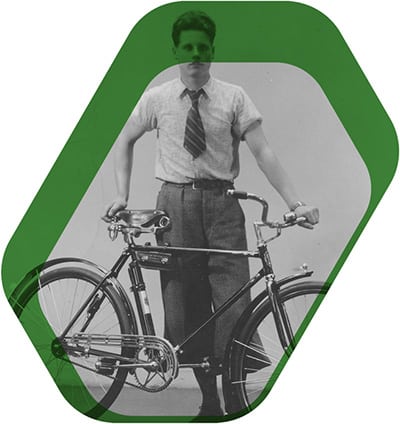
The 1930s
The global recession also reached Finland. There was a severe shortage of everything and livelihood was generally poor. An important factor that contributed to the bicycle industry surviving this era of shortages was the sale of spare parts: when people could not afford to buy new bicycles, old ones were put into use. The middle of the decade saw the selection of bikes available starting to diversify. A need for bikes equipped with low-pressure tyres was caused by the deterioration of roads due to the increase in the number of cars and their increased commercial use, for example in various professions. The first experiments with bicycle lanes were carried out in Turku and Helsinki. Competition was fierce, so whoever could provide the best combination of price, quality and distribution would end on top. Everything was regulated. The bicycle sales distribution routes became more established in the good years that followed the shortages. Pyöräkellari built their distribution around a network of exclusive dealers, mainly repair shops.

The 1940s
During the wars, there was a significant increase in the need for bicycles. The army only had a total of 7,300 bicycles, and 10,000 more were obtained from the citizens for the war. During the war, tyres and raw materials were in short supply – the needs of the army got first priority. At the beginning of 1942, the Finnish Ministry of Supply declared all bicycle tyres to be confiscated. The prerequisite for obtaining a purchase licence was a commute of no less than five kilometres, invalidity or a similar weighty justification. At the time, Pyöräkellari in Turku had ten vulcanising machines, that five employees used for repairing 30–40 tyres every day. Due to the lack of raw materials and parts, bicycle factories had to invent other products. Pyöräkellari manufactured prams, figure skates, carts for goods and delivery as well as hearses. Most important war supplies included refurbishment of grenade shells and the basic repairs of army motorcycles. Towards the end of the war, they also started manufacturing wheelchairs. The company also carried out its social responsibility by organising three-month courses for war invalids who wanted to become bicycle mechanics. The list of participants makes it clear that many would go on to establish their own shops.

The 1950s
The 1950s were a very demanding time for Tunturi. The difficulty of obtaining raw materials and the construction of a new factory caused numerous financial challenges. The year 1957 also saw the start of the serial production of mopeds, and a couple of years later the plate-framed moped that became known as the “Pappa-Tunturi”. Tunturi had already before assembled motorcycles, but there were clear reasons for the popularity of the moped: cars were still few and far between and there was also a shortage of motorcycles, which were also quite expensive. Finnish moped designers did not have many role models. A tube frame seemed like a natural solution, because it allowed making use of the experience in processing of tubes gained in manufacturing bicycles. The name of the new vehicle, on the other hand, remained problematic for a long time. The Institute for the Languages of Finland recommended “nopso”, but that never saw any use. The law classified the vehicle as a motorised bicycle, but advertising and other writing, took up the name “mopedi”, adapted from Swedish. Colloquially many used “mopo”, which was avoided at first because a competitor had named their first model “mopo”. Teollisuusyhdistys received the right to use the name “mopo” on 4 April 1959. Tunturi quickly became the leading moped factory. In the 1960s, the popularity of mopeds picked up sharply and Pappa-Tunturi took over a large part of the market. A total of 415,000 of the classic moped was sold. The production of Pappa-Tunturi ceased in 1987. When cars started to become more commonplace, the demand for mopeds aimed at adults started to wane. Tunturi stopped the production of mopeds in 1998.

The 1960s
Manufacturing only summer products was an issue for Tunturi. To balance out its production, the company ended up designing and manufacturing fitness equipment. The exercise bike was the result of long development and design work, and production which began in 1969. The year 1968 saw the introduction of the first exercise bike called a “kuntometri” (fitness meter). Its successful launch was thorough: direct advertising was used to approach the most important influencers, doctors and the authorities. Tunturi developed a completely new system for their exercise bike – a combination of a disc brake and spring balance, for which patents were applied for in Finland, England and Germany in 1968–1969. In Finland, the device was known as the Tunturi fitness meter. More than one million W1 exercise bikes were produced: its popularity was based on its ease of use. The fitness meter was the world’s first device for measuring fitness aimed at home users, and Esko Kotamäki played a significant role in the product development. In addition, the exercise bike fit into a very small space and could even be easily transported in a car. Later, the selection expanded to a rowing machine and a mechanical treadmill. Export of fitness equipment did well in the 1970s and 1980s, and it had a great impact on the development of the entire company.

The 1970s
Since the very early days, Tunturi has always offered bicycles to meet the needs of children and young people. Production of the first children’s bikes started already in the 1950s. In 1972, the boys bike “Ralli” (rally) became very popular as soon as it entered the market. It had a special “banana saddle” with a high rear bar. Other special features included a raised handlebar and a box shifter in the frame. Bicycle accessories and equipment were also part of the selection. Child seats were already available for transporting small children, providing a significant increase in safety. In the 1970s, fitness and exercise were seen as a necessary hobby for everyone. Cycling got a boost from this, as commuting by bike allowed combining exercise with utility. The energy crisis of 1973 prompted people to think about modes of transport that were more cost-effective compared to private cars. Society recommended the use of bicycles and women in particular got involved. The bicycle was seen as a solution to the problems of short-distance commuting. The number of bike lanes also increased significantly. In the mid-1970s, Tunturi reached the position of market leader. Its fitness equipment was exported to many different countries and sales operations, collections and field work all developed steadily. As a testament of this steady improvement Tunturi received the Entrepreneur of the Year award in 1976.

The 1980s
In the 80s, the “Suomi pyöräilee” (Finland cycles) campaign gathered all different parties to promote cycling. The number of bike lanes in Finland tripled in the space of ten years, increasing the number of cycling enthusiasts. Tunturi kept up a steady pace of investment throughout the decade. Robots were introduced in manufacture and surface treatment lines were revamped completely. The production of fitness equipment also continued at a brisk pace. Women’s cycling enthusiasm did not go unnoticed at Tunturi, and the company aimed to find popularity among women by developing bikes sold based on fashion and appearance. When bike sellers were increasingly branded as mere sports shops, Tunturi tried to bring out the bicycle and the brand already in shop’s appearances. Tunturi adopted the slogan “Tunturipalvelu” (Tunturi service) for all public appearances and also leveraged being Finnish in its advertising very strongly.

The 1990s
The 1990s can be considered the golden age of the mountain bike as it spread from North America to Europe and Finland. In 1993, the bicycle component manufacturer Shimano organized a design competition. Tunturi participated and placed among the top. The success kickstarted Tunturi’s manufacture of mountain bikes. Where Tunturi had competition in the manufacture of other bicycles, it was truly a pioneer when it came to mountain bikes. It used an advanced method, plasma welding, in manufacturing its unique steel frame mountain bikes, setting it apart from the competition. Tunturi also actively promoted cycling. Successful Finnish mountain bikers formed several Tunturi teams, which represented the brand at industry events and competed on Tunturi bikes. Famous team members included Katja Repo, Pia Sundstedt, Katariina Ebeling, Simo Kirssi, Marina Rantanen and Kari Myyryläinen. Tunturi handcrafted special racing bikes for downhill riders. Katja Repo won the downhill World Cup bronze in 1997 on a Tunturi Progression bike. Ilona Luukkonen won the Bike Messenger World Championships, bringing another gold medal to Finland.

The 2000s
The arrival of multi-purpose bicycles started in Finland already in the mid-1960s. In 1967, Tunturi responded to the market challenge by launching Poni bikes, which quickly became Finland’s most popular bike brand. The launch tripled Tunturi’s sales by the end of the 1960s. The idea behind the new multipurpose bikes was that all family members – from the youngest to the oldest – could use the same means of transportation. Adjusting the bikes would be as easy as possible and could be done without tools, while maintaining good rideability. Poni was ascetic in its equipment, usually single-speed. Instead, it offered several colour schemes, which taught Finns to demand trendy colours of their bicycles. Poni helped create the foundation of a new Finnish cycling culture. People began to use the bicycle for exercise, utility and leisure. Poni was re-launched in 2010. New features of Poni included a front luggage rack and basket, and 3-speed models were introduced. In addition, new, more suitable models were introduced for young people and children: Maxi 20”, Midi 16”, Mini 12” and the kick bike Micro Poni for the very smallest.

The 2010s
In the 2010s, there were an estimated 3.5 million bicycles in Finland. The role of cycling has changed over the decades – these days bikes fulfil many tasks and have many uses. A bicycle is first and foremost a means of transportation, but cycling must also be fun. Cycling as a hobby has evolved into many subcultures, and its importance as a form of exercise and sport has grown. Group cycling is emerging as a new form of cycling. Socially, cycling is viewed very positively. Finland is not yet at the level of traditional cycling countries, but cycling routes and light traffic lanes are constantly being developed. Bicycle commuting in particular has positive effects on society, reducing emissions and promoting public health. The bicycle of the future will be electric. As an example, 14% of the bicycles sold in the Netherlands are already e-bikes. An electrically assisted bicycle, or more familiarly, an e-bike, makes riding easier, especially uphill and long distances. The e-bike is especially suitable for bicycle commuters, active seniors, those without a driver’s license and ecologically minded people.

The 2020s
In the 2020s, the popularity of cycling has continued its strong growth. The number of e-bikes has also increased significantly and they offer even more opportunities for enthusiasts. Electric assistance makes bicycle commuting possible even on longer commutes. Electric assistance also provides people pedalling off-road with the opportunity to take on longer rides and more challenging trails. Fat bikes, such as the Tunturi eMax in the photo, have also gained great popularity. Rental companies all over Finland offer opportunities to enjoy nature on a fat bike.
popular categories
CUSTOMER SERCVICE
Frequently asked questions
Warranty conditions
Manual
Dealers

